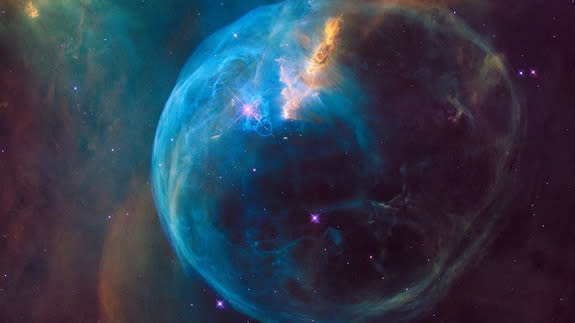Star blows blue cosmic bubble in new Hubble telescope photo

An incredibly massive star 7,100 light-years from Earth is blowing a bubble in deep space.
The star, called BD +60º2522, is about "45 times more massive than our sun," and the bubble feature — called the Bubble Nebula — is formed by gas escaping from the star's outer layers, pushed outward by the stellar wind at 4 million miles per hour, NASA said.
"This outflow sweeps up the cold, interstellar gas in front of it, forming the outer edge of the bubble much like a snowplow piles up snow in front of it as it moves forward," the space agency said in a statement.
SEE ALSO: A blue bubble shines in deep space in new Hubble photo
The new Bubble Nebula image, taken by the Hubble Space Telescope, was released to commemorate the 26th anniversary of the long-lived telescope's launch to space on April 24, 1990.
And this isn't the first time the Hubble has photographed the Bubble Nebula. The cosmic object has actually been a muse for the famous telescope for some time.
The Bubble Nebula — also named NGC 7635 — was photographed by Hubble's Wide Field Planetary Camera in 1992, and the telescope's Wide Field Planetary Camera-2 in 1999.
While the previous photos show a beautiful and colorful view of the nebula, this 26th anniversary image reveals some intricate lines of dust stretching through the nebula.

Image: NASA/ESA
Hubble has transformed our view of the universe in its 26 years of life.
The space telescope has helped scientists figure out the age of the universe, found new moons of Pluto, peered more deeply into the cosmos than ever before and led to even more discoveries.
The telescope has also produced some of the most beautiful and scientifically fruitful images ever taken of objects in our galaxy and beyond. The deep field survey revealed thousands of galaxies that have never been seen before, and Hubble's "Pillars of Creation" is arguably the most iconic deep space photo ever taken.
And the telescope isn't done with its work. Scientists think that Hubble could function into the 2020s, even after its successor, the James Webb Space Telescope is expected to come online in 2018.

